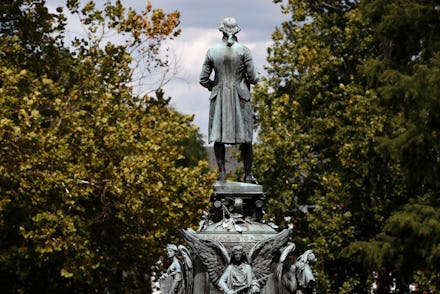Thomas Jefferson statue in Charlottesville covered up by University of Virginia group

One month after the “Unite the Right” rally and ensuing violence in Charlottesville, Virginia, sparked a movement to remove Confederate statues, another Charlottesville statue is now under scrutiny for its racist connotations.
A group of University of Virginia students, faculty members and Charlottesville residents gathered Tuesday night to protest the school’s response to the recent white nationalist rallies in Charlottesville — and the school’s statue of Thomas Jefferson, the Richmond Times-Dispatch reported. The protest was held at the Rotunda on the university campus, where the gathering of white nationalists took place in August.
The protesters covered the statue of the former president with a black tarp, echoing how the town of Charlottesville shrouded their statues of former Confederate leaders following the “Unite the Right” rally, and the statue was furnished with signs labeling Jefferson as a “racist” and a “rapist.” The crowd of approximately 100 people chanted “No Trump, no KKK, no racist UVA,” the Times-Dispatch noted, and some carried “Black Lives Matter” signs.
“The same moderates who condemn the hate that came to Charlottesville one month ago fetishize the legacy of Jefferson, and imagine him as our collective moral compass,” a speaker at Tuesday’s protest said in a speech, as quoted by the Times-Dispatch.
“We can and must condemn the violence of one month ago and simultaneously recognize Jefferson as a rapist, racist and slave owner,” she continued. “The visibility of physical violence from white supremacists should not take our attention away from condemning and disrupting more ‘respectable’ racists that continue to control the structures that perpetuate institutional racism.”
Those in attendance Tuesday called on the university to adhere to a list of demands published in August by the school’s Black Student Alliance and other student groups. The list includes banning white supremacist groups from the university campus — including high-profile white nationalists and UVA alumni Richard Spencer and Jason Kessler — and “[removing] the Confederate plaques on the Rotunda.”
“The statue of Jefferson serves as an emblem of white supremacy, and should be recontextualized with a plaque to include that history,” the student groups wrote about the Jefferson statue in their list of demands.
Additionally, the list called on UVA to require students to undergo education on “white supremacy, colonization and slavery as they directly relate to Thomas Jefferson, the university and the city of Charlottesville.”
In the wake of the Charlottesville “Unite the Right” rally, which centered on Charlottesville’s potential removal of its Confederate statues, many of the ensuing efforts by anti-racist advocates have focused on the removal of Confederate monuments, which are seen to be symbols of white supremacy. Some protesters’ efforts have expanded to include statues of other historical figures carrying racist connotations, though, such as Christopher Columbus and Dr. J. Marion Sims, who experimented on enslaved women.
Tuesday’s protest, however, continues a long-gestating dissatisfaction among members of the University of Virginia community with Jefferson, who founded the university in 1819.
In November, 469 students and staff members at the university signed an open letter to university president Teresa A. Sullivan criticizing Sullivan’s evocation of Jefferson and his quotations in letters to the UVA community, including one following the election of Donald Trump.
“We are incredibly disappointed in the use of Thomas Jefferson as a moral compass,” the open letter reads, as quoted by CBS 19. “In the spirit of inclusivity, we would like for our administration to understand that although some members of this community may have come to this university because of Thomas Jefferson’s legacy, others of us came here in spite of it.”
“We understand desires to maintain traditions at this university, but when these traditions threaten progress and reinforce notions of exclusion, it is time to rethink their utility,” the letter continues.